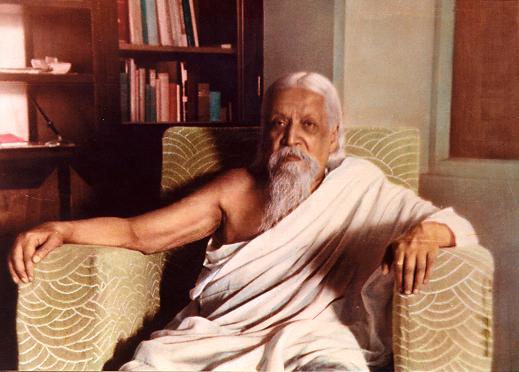Sri Aurobindo is one of India’s greatest philosophers and August 15 is not only Independence Day, but also his birthday, and therefore a day to reassess and understand his philosophy.
A key element of some Eastern religions, for instance Hinduism, Buddhism and Jainism, is the ultimate aim of moksha or nirvana, liberation from the cycle of life and death. In many Hindu schools of thoughts, moksha implies uniting with the divine or living in a divine presence.
Delving deep into ancient Indian texts, Sri Aurobindo’s philosophy presents a different view, focusing on a transformation of the world and of individual consciousness. In this scheme, union or contact with the divine is just the first step, the main aim being to establish the divine on earth.
Scientists recognise that human beings are the product of evolution, but Sri Aurobindo affirms that they are still evolving, moving towards a higher entity. Evolution is not merely physical, the human life and mind are also evolving towards an ultimate spirituality and an increasing universality. The light and power of the spirit, also called by him, the ‘Supermind’, presiding over human evolution has the potential to transform human consciousness and remould life on earth.
His basic philosophy is what he called Integral Yoga. The aim of this, according to him, is “to enter into a higher Truth-Consciousness or Divine Supramental Consciousness in which action and creation are the expression not of ignorance and imperfection, but of the Truth, the Light, the divine Ananda (bliss).” The divine has to be brought down into the whole being, including the cells of the body.
He did not prescribe any fixed method for this, but suggested various ways to make oneself receptive and open to receive the divine, including surrender and devotion, meditation, and detachment while following the path of action.
Sri Aurobindo’s life was out of the ordinary. Aurobindo Ghose or Aravinda Ackroyd Ghose was born at Calcutta (Kolkata) on 15 August 1872, but at the age of seven, was sent to England to study. Returning to India as a young man in 1893, he worked for some time in the state of Baroda, but gradually got involved in the freedom movement against the British, who ruled most of India at this time.
He had already begun certain yoga practices, and when in prison for his actions in the struggle for freedom, he received a divine revelation.
In 1910 he left British India and entered the small territory of Pondicherry (Puducherry) in south India, which was then under the French. Here he could not be pursued by British authorities, and giving up politics he developed his own philosophy.
He was joined in 1920 by ‘The Mother’, a Frenchwoman named Mirra Richard. Together they founded an ashram in 1926, and while the Mother ran the ashram, Aurobindo remained in seclusion, reading, studying ancient texts and writing, only appearing for ‘darshan’, three or four times a year. A prolific writer, his main philosophical works include The Life Divine, The Synthesis of Yoga and the epic Savitri, a poem with 24,000 lines, apart from several other works, as well as letters providing guidance to spiritual aspirants, and commentaries on some major ancient texts.
In Savitri, while recreating the story of Savitri and Satyavan from the Mahabharata, he gives it an entirely new flavour, as a representation of the path to divine consciousness. Explaining his work, he calls it ‘a symbolic myth’.
He says, “Satyavan is the soul, carrying the divine truth of being within itself, but descended into the grip of death and ignorance; Savitri is the Divine Word, daughter of the Sun, goddess of the supreme Truth, who comes down and is born to save; Ashwapati, the Lord of the Horse, her human father, is the Lord of Tapasya, the concentrated energy of human endeavour that helps us to rise from the mortal to immortal planes; Dyumatsena, Lord of the Shining Hosts, father of Satyavan, is the Divine Mind here fallen blind, losing its celestial kingdom of vision, and through that loss its kingdom of glory.
Still this is not a mere allegory, the characters are not personified qualities, but incarnations or emanations of living and conscious Forces with whom we can enter into concrete touch and they take human bodies in order to help man and show him the way from his mortal state to a divine consciousness and immortal life.” Another significant work of his is The Human Cycle which looks at the aim of evolution and of life’s ultimate destiny.
In these works, apart from putting forth his theory of divine life to be established on earth, he questioned many traditional concepts of Indian philosophy, including the commonly accepted views of the world as Maya or illusion and of Karma. He believed that the world is a real manifestation of the divine and should not be seen as unreal. The concept of karma implies that all aspects of existence depend on the workings of universal energy.
However, he explained it was not a simple law of reward and punishment as is commonly perceived, but something extremely complex. Though Sri Aurobindo lived in seclusion for much of his life, reading, reflecting, meditating and writing out his theories in a logical way, he was never out of touch with what was happening in the world.
It is interesting that during the Second World War, he listened to the radio every evening, and stayed up to date with war news. He understood the menace of Hitler before most others did, and supported the British during the war, something that many of his followers could not understand.
After his death on 5 December 1950, the Mother continued with his work, running the ashram, setting up Auroville, and continuing with her own sadhana of spiritual and bodily transformation, until her own death in 1973.

